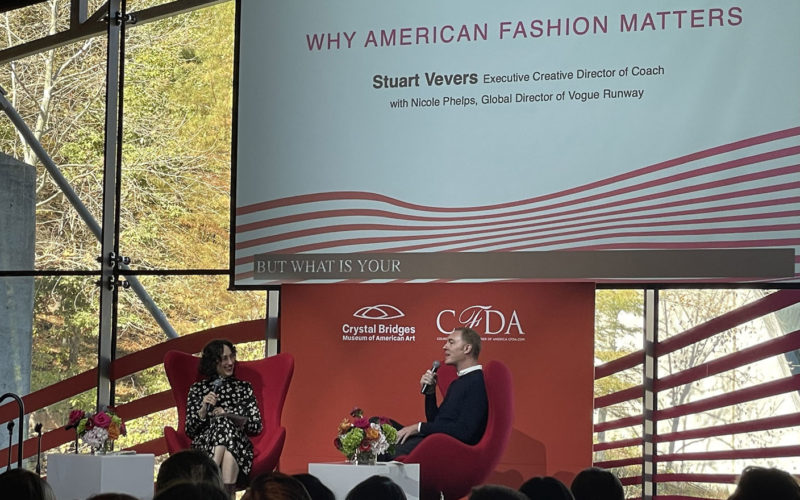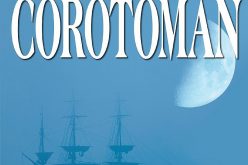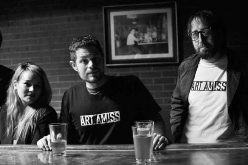April Wallace
awallace@nwaonline.com
Fashion has been a hot topic in Northwest Arkansas the past few months.
That’s due in part to the opening of “Fashioning America: Grit to Glamour,” Crystal Bridges’ first fashion exhibit that opened in September; a locally held fashion symposium with Council of Fashion Designers of America; and INTERFORM’s NWA Fall Fashion Week last weekend.
The fashion symposium with CFDA took place at Crystal Bridges Museum of American Art on Oct. 26 and brought in speakers from popular brand names and fashion designers from Coach, Nike — and Tommy Hilfiger himself. Crystal Bridges Board Chairwoman Olivia Walton announced a new heartland scholars award that day.
We caught up with Stuart Vevers, executive creative director of Coach, shortly before the events began.
Vevers opened the symposium with a discussion with Nicole Phelps, global director of Vogue Runway, on “Why American Fashion Matters.” Both have been in the fashion industry since the mid-1990s and share a similar outlook on American fashion due to their involvement in some of the world’s biggest design companies and events, like Milan Fashion Week.
Vevers is a graduate of London’s University of Westminster and had lead accessories design roles at Italian luxury fashion house Bottega Veneta, French luxury fashion and perfume house Givenchy and Louis Vuitton, but he says he was drawn to American style, which made him want to work for Coach.
Phelps said American fashion often gets a bad rap for being practical and everyday, but that’s exactly what Vevers admires about it.
“Something about the ease of a certain everydayness and (it had) a sense of reality that for most of my career I could not have focused on,” Vevers said. “I’ve certainly focused on that at Coach, celebrating the everyday is part of what the American fashion legacy is.”
Vevers joined Coach in 2013 and handles all the company’s design, its runway collection, imagery, store design — all things creative and aesthetic in the world of Coach. He likes to say that he’s a designer first and a creative director second. Vevers still sketches and works in fittings with Coach teams, but these days what he’s most inspired by are entirely new projects he’s never approached before.
“When I joined Coach, I’d never worked on fragrance before and so learning that process from creating the scent to everything that goes into it was really inspiring and something I love to do now,” he says. The ever-present challenge that fashion presents is exactly what he loves most about it. “People will often ask, ‘What do you see as the future of fashion’ or ‘What do you see fashion in five or 10 years?’ My answer is usually ‘I have no idea’ because fashion reflects the time we live in. It’s just constantly changing.”
Vevers spent most of his fashion career to this point working in Europe, but his first job after school was in New York at Calvin Klein. That’s when he first began to think about what makes American fashion different. What do Americans have to be proud of when it comes to their style? Vevers believes the pure practicality of it, which can sometimes be looked down upon, is actually something to be celebrated.
“I think it honestly reflects the way most of us dress today,” Vevers says, noting that he loves to celebrate and elevate the everyday. While it may be clear to most of us now that the pandemic influenced the average person’s style and the level of comfort they seek in their clothing choices, he believes the move toward comfort and practicality began even before the shutdown.
In the fashion industry, there was much discussion about whether the return to the workplace and to in-person events would lead to a new wave of dressing up, like what happened in the 1920s, but Vevers says he never saw that happen. Instead came a deeper turn inward to the sensory aspects of clothing.
“Once people got used to a certain feeling that their clothes gave them, it wasn’t so easy to give that up,” Vevers says. “I think there’s more of a balance now, but even when I see people dressing up today, it feels like there’s a nod to the comfort that they got used to when so many of us were working from home.”
Even when he encounters a pair of more sophisticated, elevated looking shoes, it still maintains a strong element of comfort. Vevers thinks this is customers saying they want the best of both worlds — to look good and feel good at the same time. He keeps that in mind no matter what he’s designing. A dress, for example, should have the ease of a simple white T-shirt.
Vevers is currently excited about the Coach fall collection that he’s working on and describes it as a time that he gets to work with materials the company is really known for — leather or shearling.
Among the biggest focus areas he’s had since the pandemic is a number of sustainability measures for Coach that will come to fruition in the spring. Not only does sustainability in fashion mean an intentionality with the materials used, but also interest in encouraging longevity of the products they create, Vevers says.
“We started a program at Coach called ReLoved, (in which we are) taking ownership of the product in its whole journey,” he says. “If a bag is at the end of its life with one person, people can now bring it back to Coach, and we find a way to reuse it.”
In that process, Coach might reuse the material or restore the bag. In some cases, depending on the level of potential damage it has, they may repurpose it to create a new one-of-a-kind piece. When Vevers travels in London, Tokyo or New York, he now sees young people carrying Coach bags that are 40 or 50 years old and wonders how many people have enjoyed that piece, then takes pride in that approach to sustainability that’s so important for the industry.






